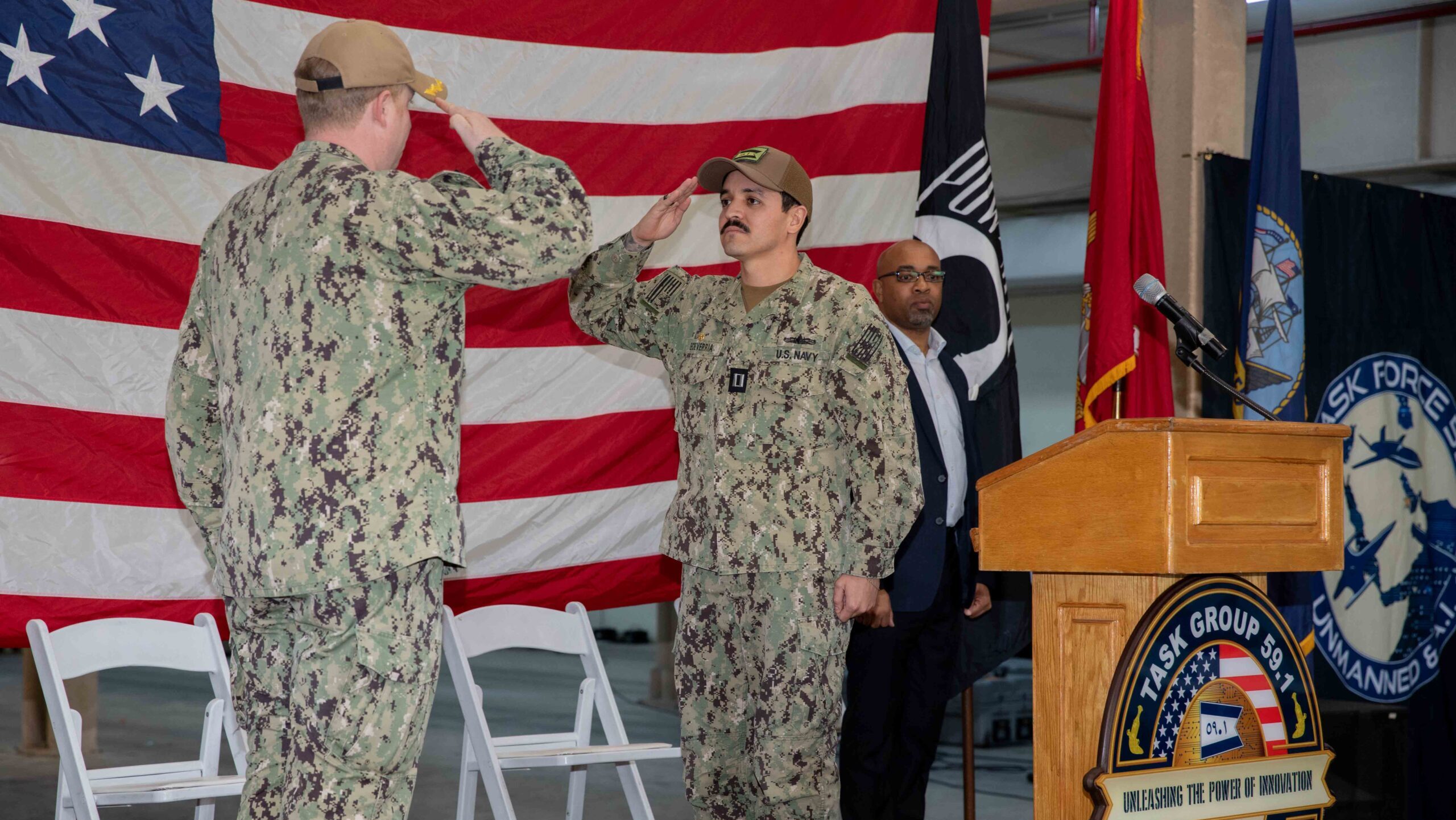AGNES HELOU

BEIRUT — After the US Navy’s Task Force 59 identifies an unmanned system it wants to use in the Middle East, it’s up to one of the service’s newest Task Groups, 59.1, to bring that tech into the “operational realm” so it can be used in real-world ops, according to 59.1’s chief.
“[While] the intent of Task Force 59 has been to bring new systems, experiment [with] those systems and see the value in them, [bringing] valuable assets to the theater in this region will come under the realm of Task Group 59.1 and we will take them to the operational realm,” Lt. Luis Echeverria, the newly appointed commander of Task Group 59.1, told Breaking Defense in an interview today.
“We’re ultimately developing the next generation of sailors that will operate the hybrid fleet. The hybrid fleet in specific [includes] the manned and unmanned vessels integration and we’re showcasing that within [this] theater, but that is going to evolve Navy-wide,” he said.
Task Group 59.1 was commissioned on Jan. 3, and will focus on the “operational deployment of unmanned systems teamed with manned operators to bolster maritime security across the Middle East region,” according to a US Naval Forces Central Command announcement on Jan. 16. The group carries the nickname “The Pioneers”.
With a motto of “Unleashing the Power of Innovation,” 59.1 will operate throughout the area of operations for the Bahrain-based US 5th Fleet, encompassing the Arabian Gulf, the Gulf of Oman, the Gulf of Aden, the Arabian Sea, parts of the Indian Ocean and covering crucial sea trade bottlenecks like the straits Bab El Mandeb and Hurmuz and the Suez Canal.
“We are bringing budding, relevant technology to warfighters and doing it fast,” Capt. Colin Corridan, Task Force 59 commodore, said in the NAVCENT release. “Breaking the molds of the legacy acquisition model requires a level of connective tissue between industry partners and the end user operators, and 59.1 answers that bell. Our sailors will be there to ensure seamless integration of new tech introduced to operators while in theater.”

Capt. Colin Corridan, commander of U.S. Naval Forces Central Command’s Task Force 59, and Lt. Luis Echeverria, commander of Task Group 59.1, salute during a commissioning ceremony for Task Group 59.1 in Manama, Bahrain, Jan. 3.
Echeverria told Breaking Defense that as of now, the group is working with two partner nations — the United Kingdom and New Zealand — but he said that 59.1 is open to other partners joining. He added that the group is carrying out the operations for the US and is integrating with ships, whether that’s US Navy, Coast Guard or other ships within the international Combined Maritime Force.
“We are operating a variety of different robots, any of the robots that Task Force 59 has conducted [experiments with] within the 5th Fleet AOR [area of responsibility] and have been proven to be sustainable assets,” he told Breaking Defense.
Echeverria said 59.1 is working with some unmanned surface vessels including the MARTAC T-38 Devil Ray, MARTAC T-12 12 Mantas, L3 Harris Arabian Fox, Seasats Light Fish, and unmanned underwater vehicles like the Ocean Aero Triton.
Regarding the manned platforms that are teamed with these unmanned systems, Echeverria said that it could be any kind of CMF asset.
The establishment of 59.1 comes amid a particularly turbulent time in the Middle East with the conflict in Gaza and Houthi attacks on commercial shipping in the Red Sea. But Echeverria said the group’s formation wasn’t related to recent event in particular and has been long in the making.
“This has been planned for a while. I am a surface warfare officer, and this is an early command position for a lieutenant. After selection process, I was selected over the summer and went through the command pipeline back in the United States. So this has been a planned concept for a really long time now,” he said.
Task Force 59 was the first naval unmanned and artificial intelligence task force and was established in 2021. It has tested robots and unmanned systems since it was inaugurated, and seen enough success that the Navy is aiming to replicate it elsewhere.
“We have seen that these unmanned systems are valuable assets to this theater. A good example is our Digital Talon Exercise, when we did the launch of a T-38 Devil Ray,” 59.1 commander said.
Though 59.1 is new, the Navy’s operational use of unmanned systems is not. Unmanned surface vessels, for instance, have sailed the Arabian Sea for some time — two were the targets of Iranian drone-napping incidents in 2022.
No comments:
Post a Comment